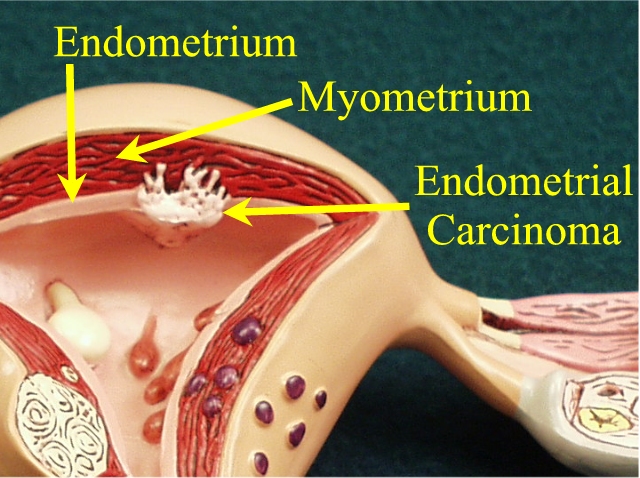|
Endometrial Carcinoma |

 Endometrial cancer is the single most common genital tract malignancy in
women. A woman's lifetime risk of ever developing endometrial cancer is
about 2%. Peak incidence is between age 50 and 65.
Endometrial cancer is the single most common genital tract malignancy in
women. A woman's lifetime risk of ever developing endometrial cancer is
about 2%. Peak incidence is between age 50 and 65.
Endometrial cancer arises from the glandular cells of the uterine lining. The most common form of this occurs among women exposed to chronic, unopposed estrogen.
- Estrogen stimulates the uterine lining to proliferate, becoming lush and thick. Normally, estrogen is episodically opposed by progesterone (produced with ovulation). Progesterone inhibits the proliferative growth effects of estrogen, and provide structural support to the soft, otherwise friable endometrium. With the withdrawal of progesterone at the end of the menstrual cycle, the structural support to this thickened endometrium is weakened, and shedding of the uterine lining occurs.
- Without this cyclic progesterone exposure and episodic shedding, the uterine lining becomes too thick and the endometrial glands too crowded. This is called endometrial hyperplasia. Should the hyperplasia go unchecked, some degree of cellular atypia often develops. Ultimately, the glandular cells look and behave so atypical that they begin to invade through the basement membrane...cancer of the endometrium.
Thus, most cases of endometrial cancer arise from endometrial hyperplasia because of chronic, unopposed estrogen stimulation. Clinically, this situation might arise in a chronically anovulatory patient, or an obese patient, whose body fat cells are converting androstenedione to estrone. Endometrial carcinoma has been associated with a number of clinical conditions, but the apparent common final pathway to cancer is chronic, unopposed estrogen.
Not all cases of endometrial cancer arise in this fashion. There is a subgroup whose cancer does not appear to be estrogen dependent. These cancers usually arise in older women, tend not to be associated with endometrial hyperplasia, and tend to be unusually aggressive and less responsive to usual treatment.
Abnormal bleeding is the classical symptom of endometrial cancer. Because abnormal bleeding is widely viewed as a danger sign, and because of the availability with simple endometrial biopsies, many cases of endometrial cancer never occur. During the hyperplasia stage, abnormal bleeding develops which is evaluated by sampling of the endometrium. The hyperplasia is treated with progestins, and a subsequent cancer avoided.
Thus, a common approach to a woman at risk for endometrial cancer (post-menopausal, for example), is to sample the endometrium whenever abnormal bleeding is encountered. There may be exceptions to this general approach, but sampling may involve endometrial biopsy, D&C, and/or hysteroscopy. Recent advances in ultrasound technology have led to increased use of this technique, particularly when combined with intracavitary infusion of saline to outline the endometrial structures more clearly.
In those cases in which the cancer is not avoided, treatment varies, depending on the extent of the cancer. One factor influencing choice of treatment is the staging of the disease:
| Stage |
Extent of Disease |
| I | Cancer limited to the uterine body (corpus) |
| II | Cancer extends into the cervix, but not beyond the uterus. |
| III | Cancer extends beyond the uterus, but only so far as the peritoneum, adnexa or vagina |
| IV | Cancer extends into the bladder, bowel, or to distant sites |
Within each stage are subgroups (eg, Stage IA, IB, IC) that distinguish the extent of disease within each stage.
Other factors influencing the choice of treatment include tumor grade, histologic subtype, age, race, depth of endometrial penetration through the uterine wall, and presence or absence of positive peritoneal cytology and distant metastases. Among the choices for treatment are simple TAH/BSO, pelvic/periaortic lymphadenectomy, radiation therapy and chemotherapy. Prognosis for the lower stage, better differentiated tumors is excellent. For more advanced cancers, the prognosis is not as good.
Typical management of these patients consists of:
- Identifying the patient with endometrial cancer.
- Staging the cancer to enable selection of the best therapy.
- TAH/BSO for Stage I and possibly some Stage II patients
- Whole pelvis irradiation for more advanced cases, either as an adjunct to surgery or instead of surgery.
- Additional irradiation to periaortic areas if metastases are present
- Possible chemotherapy for very advanced cancers.
- Surveillance for recurrence.